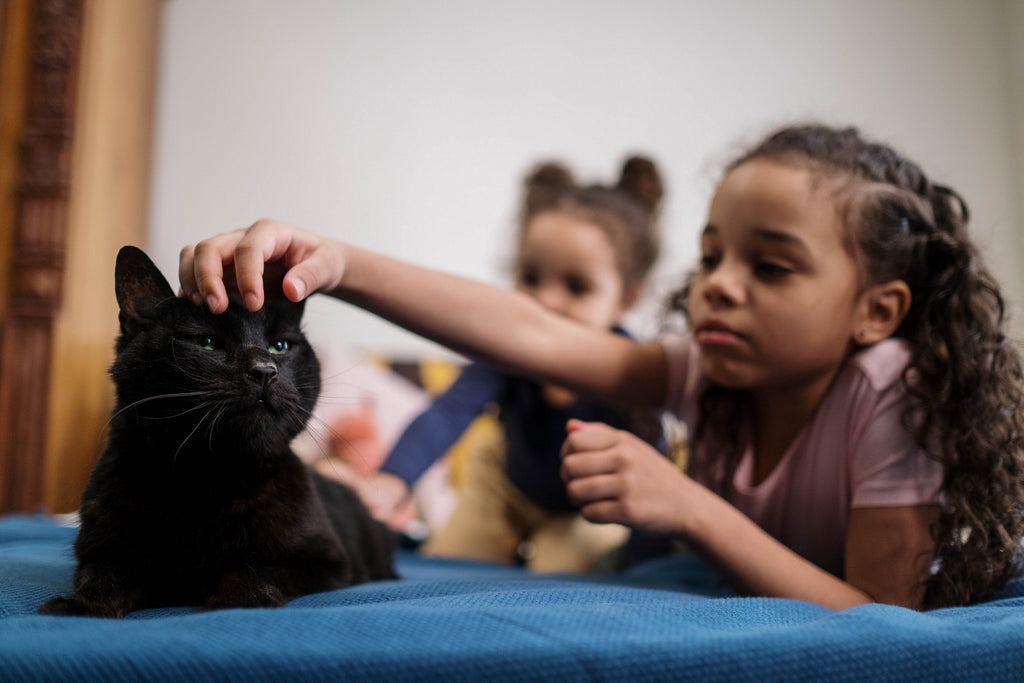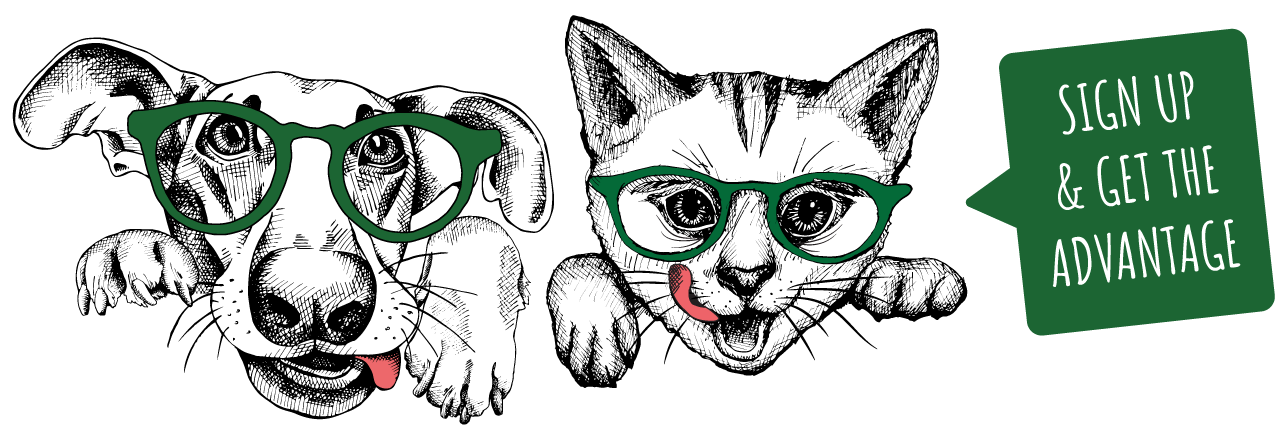Are Black Dogs and Cats Less Likely to be Adopted?

“Black Pet Syndrome” is the name of the anecdotal phenomenon observed by rescue workers and volunteers that black-colored pets may be more difficult to adopt out than pets with other coat colors.
Pet professionals across the country regularly swear that they’ve seen “Black Pet Syndrome” in action first-hand. Some even believe “Black Pet Syndrome” applies beyond dogs and cats to include any black-colored pet, such as rabbits.
But are potential adopters really discriminating against black pets — and if so, why?
Shelter workers and researchers have proposed three possible explanations for why black pets could have a harder time getting adopted than their multi-colored brothers and sisters.
Dark Myths & Superstitions
Black dogs (especially big, black dogs) have been portrayed in various media and cultural stories as a bad omen, possibly influencing potential adopters’ subconscious impressions.
English and Celtic folklore describes many malevolent spirits and ghosts as black dogs, including the “Church Grim” that haunts church cemeteries, the evil Barghest of Yorkshire, and the ghostly Dartmoor hounds that inspired Sir Arthur Conan Doyle’s The Hounds of Baskerville. Black dogs are also commonly linked with “hellhounds” or portrayed as guardians of the underworld.
In more modern times, Winston Churchill popularized using the imagery of a black dog to represent depression. References to the “black dog of depression” still exist, perhaps building a subtle negative association with black dogs.
Hollywood movies and other sources of pop culture commonly support the harmful idea that black is a more aggressive, angry or evil color overall, with black animals and certain dark-colored dog breeds (like Dobermans and Rottweilers) consistently portrayed as villains.
Black cats also suffer from a superstitious reputation, as they have been linked with witchcraft, Halloween and “unluckiness” for many years.
Out of Sight, Out of Mind
Another possible reason why potential adopters may overlook black pets is that they don’t have the opportunity to see black pets very well.
The first glimpse many pet-parents-to-be have of their future best furiend is on a local rescue’s website, or on a larger database like Petfinder. It’s true that you only get one chance at a first impression, and a pet’s profile photo online can either lure in interested searchers…or let them scroll on by.
Unfortunately, black pets often suffer from poor photographs on these websites. To be clear, this is not because “black pets don’t photograph well” — black pets do photograph beautifully! However, many people don’t know how to photograph black pets in a way that lets their true personalities shine through.
All too often, a black pet’s photo online is simply a dark blurr, their lovely features indistinguishable. This is particularly true in rural or poor areas, where shelters and rescues may not be able to afford the skilled photographer or equipment they would need to take more appealing photographs.

Both of these adoptable black dogs are gorgeous pups, but Keanu's playful personality shines through his photo (left) while Boo's gentle eyes are lost in this lighting (right).
To make matters worse, when interested adopters actually visit the shelter, a black pet curled up in the shadowed corner of their enclosure is almost invisible to passers-by.
This problem is especially exacerbated if the shelter contains a long row of black dogs or black cats (and as black is a very common coat color, this is entirely possible). This can create the false impression that all of these black pets are interchangeable or look exactly the same — making it harder for one of these beautiful animals to stand out as unique and grab an adopter’s attention.
An Emotional Connection
Human communication relies heavily on facial expressions, and we are drawn to animals whose expressions appear to be easy to read. (In fact, domestic dogs evolved completely unique facial muscles just so they could make more compelling and communicative facial expressions that we understand!).
That’s why one theory to explain “Black Pet Syndrome” is that it may be harder to read the distinct facial expressions of a solid-colored black pet — making it less likely that adopters will feel a “spark” of connection when they gaze into those soulful eyes.
Are Black Dogs and Cats *Really* Less Likely to be Adopted?
There are many possible explanations for Black Pet Syndrome, but the biggest question has yet to be answered definitively: Does Black Pet Syndrome even exist? In other words, is it even true that black dogs and cats have a harder time getting adopted?
There’s been a variety of studies over the years attempting to answer that very question. Some of these studies noticed trends that may lead to “Black Pet Syndrome” — and some didn’t.
For example, a 2013 study by Penn State psychologists found that black dogs were more likely to be judged as unfriendly and more aggressive compared to dogs of other colors. Also, an examination of Petfinder trends in 2015 found that on average, black cats receive less clicks than cats of other colors.
However, several other studies found no evidence of “Black Pet Syndrome,” and found instead that black pets do get adopted at the same rate as other colors.
One study at two New York animal shelters in 2013 found that coat color had no effect on pets getting adopted. Similarly, an ASPCA study in 2012 examining five shelters across the United States found that adopters mainly chose dogs based on breed, and chose cats based on behavior, rather than appearance.
Perhaps one of the most noteworthy studies into “Black Pet Syndrome” came from the Los Angeles Animal Services Department in 2008. They reported that of the 30,046 dogs picked up over the course of one year, 27% of the dogs were mostly black — and 28% of the dogs that were adopted that year were also black. So, happily, black dogs did leave the shelter into loving homes at the same rate that they came in as strays!
However, a spokeswoman for one of the LA rescues did note that while the average wait at her shelter is two weeks, black dogs at her shelter often waited a little bit longer to find their furever homes.
What Pet Parents Really Want
The big takeaway from these studies is that if any negative views of black-colored pets do exist, those views don’t seem to be widespread or urgent enough to significantly influence adopters’ final decisions. These studies show that while black pets may or may not take longer than other colors to get adopted, they do get welcomed into loving homes eventually.
Even in cases when color does seem to matter to adopters, other factors such as breed, size, age, and energy level all play a much greater role in the final decision.
Furthermore, although “Black Pet Syndrome” is up for debate, there’s no doubt whatsoever that breed stereotypes exist and sway the decisions of potential adopters. Despite the mountains of evidence that no dog breed is inherently more aggressive than another, a small, black Scottish Terrier is likely to be adopted much faster than a medium-sized, brindle American Pit Bull Terrier — even if both dogs are equally friendly.
Plus, at the end of the day there will always be those animal lovers who love black pets! Some of the most beloved dog breeds in the world, like Labs and Poodles, are commonly black-colored and this has not hurt their popularity in the slightest.

Even black cats don’t have it as tough as you might think. It’s true that black cats have long been associated with witchcraft — but in fact, many people today actually enjoy and embrace those “witchy” connotations.
The popularity of famous pop culture black cats like Salem and Binx also casts black cats in a positive light. So it’s safe to say that all-black cats will always have plenty of devotees!
Of course, all this raises the question — if “Black Pet Syndrome” doesn’t really exist (or is at least exaggerated) then why does the perception persist?
That’s most likely due to a “base rate fallacy”. Black is a very common coat color, which means there’s inevitably a lot of black cats and black dogs in shelters at any one time.
Efforts to Counteract “Black Pet Syndrome”
Regardless of the studies, many shelter and rescue workers are so convinced of the power of “Black Pet Syndrome” that many organizations arrange special events to highlight the “plight” of black pets. Marketing materials repeatedly emphasize the elegance, sophistication, and cool-factor of an all-black pet.
Other steps rescues may take to improve the adoptability of black pets include teaching them to sit at the front of their enclosure when visitors arrive, teaching them tricks, and making a special effort to take high-quality photos and videos that showcase each kitty and pup’s personality.
To push back against the idea that black pets aren’t photogenic, photographer Fred Levy started the Black Dogs Project. His series of gorgeous and elegant photos of black dogs and cats proved decisively that it is possible to photograph black pets well. Levy also works to provide shelter employees and volunteers with easy-to-follow tips on taking better photos of black pets.
Finally, unique names also make a big difference when attracting adopters. It may sound silly, but naming a black cat “Jellybean” really can give her an edge over the hundreds of black cats named “Midnight” or “Shadow”.
Rescue workers will swear they’ve seen “Black Pet Syndrome” in action, but the available data doesn’t actually show widespread discrimination against black pets.
At the end of the day, whether “Black Pet Syndrome” is a real phenomenon or not, it’s good to remind prospective adopters to judge animals on the uniqueness of their personality — not the color of their coat or other superficial physical characteristics.
Besides, it’s impossible to deny black dogs and cats are simply stunning!

